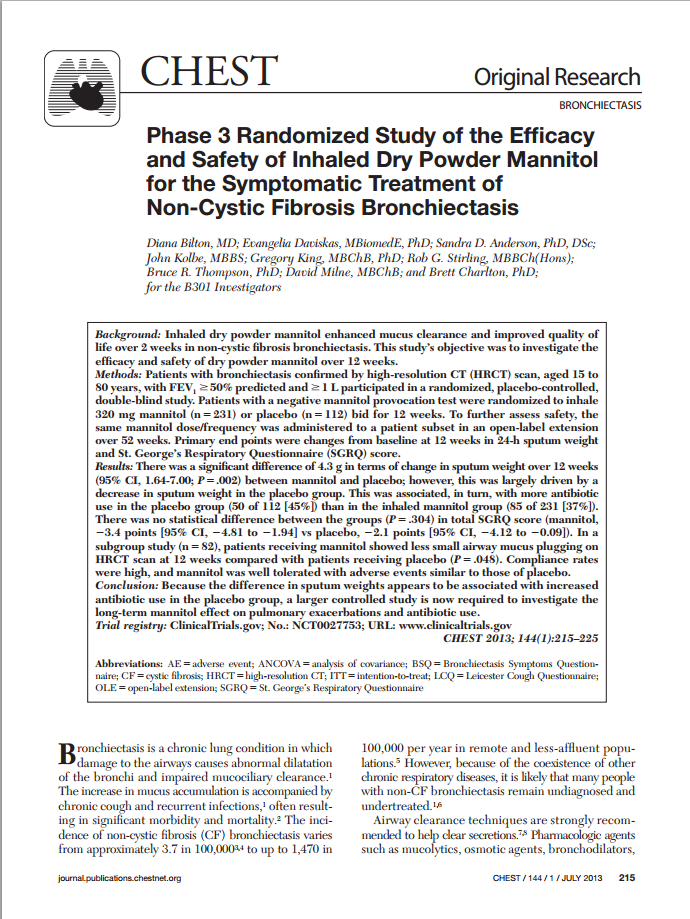
Phase 3 randomized study of the efficacy and safety of inhaled dry powder mannitol for the symptomatic treatment of non-cystic fibrosis bronchiectasis.
Bilton D, Daviskas E, Anderson SD, Kolbe J, King G, Stirling RG, Thompson BR, Milne D, Charlton B; B301 Investigators.
Link to publication page: http://www.ncbi.nlm.nih.gov/pubmed/23429964
Journal Ref: Chest. 2013 Jul;144(1):215-25. doi: 10.1378/chest.12-1763.
Abstract:
Inhaled dry powder mannitol enhanced mucus clearance and improved quality of life over 2 weeks in non-cystic fibrosis bronchiectasis. This study's objective was to investigate the efficacy and safety of dry powder mannitol over 12 weeks. Patients with bronchiectasis confirmed by high-resolution CT (HRCT) scan, aged 15 to 80 years, with FEV1≥50% predicted and ≥1 L participated in a randomized, placebo-controlled, double-blind study. Patients with a negative mannitol provocation test were randomized to inhale 320 mg mannitol (n=231) or placebo (n=112) bid for 12 weeks. To further assess safety, the same mannitol dose/frequency was administered to a patient subset in an open-label extension over 52 weeks. Primary end points were changes from baseline at 12 weeks in 24-h sputum weight and St. George's Respiratory Questionnaire (SGRQ) score. There was a significant difference of 4.3 g in terms of change in sputum weight over 12 weeks (95% CI, 1.64-7.00; P=.002) between mannitol and placebo; however, this was largely driven by a decrease in sputum weight in the placebo group. This was associated, in turn, with more antibiotic use in the placebo group (50 of 112 [45%]) than in the inhaled mannitol group (85 of 231 [37%]). There was no statistical difference between the groups (P=.304) in total SGRQ score (mannitol, -3.4 points [95% CI, -4.81 to -1.94] vs placebo, -2.1 points [95% CI, -4.12 to -0.09]). In a subgroup study (n=82), patients receiving mannitol showed less small airway mucus plugging on HRCT scan at 12 weeks compared with patients receiving placebo (P=.048). Compliance rates were high, and mannitol was well tolerated with adverse events similar to those of placebo. Because the difference in sputum weights appears to be associated with increased antibiotic use in the placebo group, a larger controlled study is now required to investigate the long-term mannitol effect on pulmonary exacerbations and antibiotic use.BACKGROUND:
METHODS:
RESULTS:
CONCLUSION:


